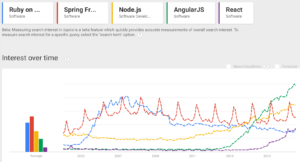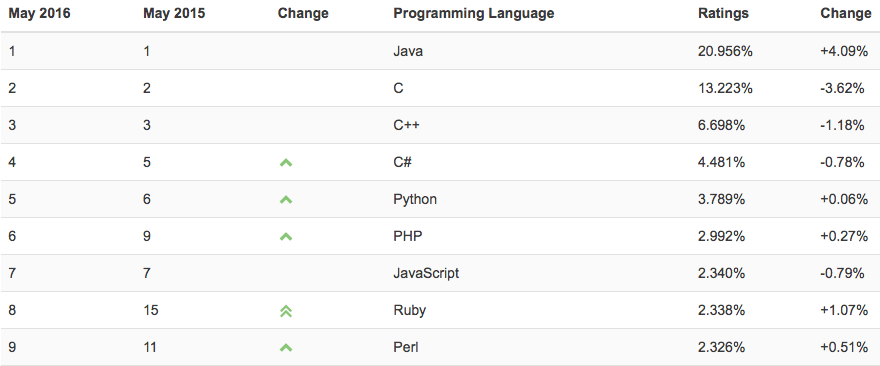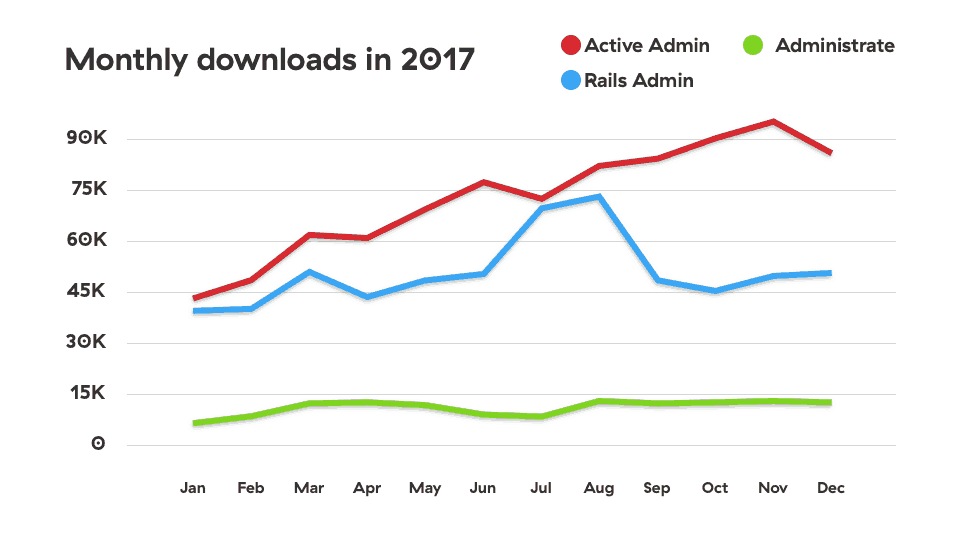According to this blog post Active Admin monthly downloads nearly doubled last year to almost 3,000 times a day. Part of that can probably be attributed to increasing use of continuous integration, but more interesting is that Active Admin has outpaced the competition. Possible contributing factors include three releases, including a 1.0 release that coincided with RailsConf and was featured by Ruby Weekly, a GoRails episode by Chris Oliver at the end of 2016, and the blog post by Charlie Gleason on using Active Admin as a back end to a React application, that has been discovered and tweeted by new fans repeatedly. I’ld love to think that timely responses to GitHub issues and pull requests and StackOverflow answers have helped also, along with the curated wiki and continuing contributions by plugin authors. Also there have been Japanese blog posts and activity so more adoption there. At this point Active Admin has 7,800 GitHub stars and 2.9M downloads, it will interesting to see how things are another year from now.
Category: software development
RubyConf 2017
Arbre vs React
Arbre is a component based server side DOM rendering library written in Ruby. Arbre was extracted from Active Admin from 2011-2012 but has not gained widespread use elsewhere. As of September 2017 there were around 4M downloads to date from RubyGems and barely 450 stars on GitHub.
class Panel < Arbre::Component
builder_method :panel
def build(title, attributes = {})
super(attributes)
h3(title, class: "panel-title")
end
end
React is a component based isomorphic DOM rendering library written in Javascript. npm downloads have reached 40M in the past couple of years and the project has 75,000 stars on GitHub: it’s no contest really. If you prefer Ruby over ES6 an Opal wrapper is available as hyper-react .
class App < Hyperloop::Component
render(DIV) do
MainNavigation {}
PageContents {}
Footer {}
end
end
The APIs for both are relatively simple.
Arbre has builder_method to register components. Each component has a build method which adds tags to an Arbre::Context that is eventually output using to_s.
React components have a render method that adds elements to a virtual DOM that is synchronized with the browser DOM as needed.
The most obvious difference is that Arbre does not integrate Javascript event handlers: it uses an unobtrusive approach that leaves registering event handlers to accompanying ES6/Coffeescript/Opal files.
Being exclusively server-side means that Arbre can and has been used with ActionView helpers and templates. There are bugs but it mostly works. Arbre is relatively simple and provides what Active Admin needs without further dependencies.
React components are careful about maintaining state and re-render when state is changed. Arbre components get re-instantiated for each request and are more ad hoc.
Is anything to be learned from this comparison? The prospects of widespread adoption of Arbre are slim to none. An increasing number of developers are going to be looking to use a Rails admin framework with React, and that is where opportunity lies.
Year 7 with Rails
RailsConf 2017, Phoenix, AZ
Tuesday. Day 1. Keynote by DHH on belief systems. Fascinating talk by Lance Ivy on JSON Web Tokens, Justin Weiss on sessions, Dave Tapley with an entertaining exploration of VueJS, ActionCable and image processing. Eileen Uchitelle with a much anticitpated presentation on adding a significant feature (SystemTestCases) to Rails. Alex Kitchens with a great primer on using Git to explore the history of the Rails codebase. Finally Sam Phippen, now with Digital Ocean, in much better health than last year, giving an upbeat tour of fixing some RSpec issues.
Wednesday. Day 2. Justin Searles keynote with a tongue-in-cheek programmer personality test inspired by Myers Biggs. Back to back presentations on Elm, Phoenix, React and Helix highlighting various Rails related technologies. Nate Berkopec with clear and practical guidance on configuring app servers on Heroku or elsewhere. Evening lightening talks, most notably Isaac Sloan building a Crystal Kemal blog in five minutes.
Thursday. Three talks on distributed teams, including Maria Gutierrez, Glenn Vanderburg, formerly of Living Social, and David Copeland of Stich Fix. Simon Enskilden on the decision at Shopify to embrace flash sales and scale from MySQL sharding to multi-datacenter ‘pods’. Tony Drake pitching his active_reporting gem, then Nate Berkopec and Eilieen Uchitelle again with Rafael Franca and Richard Schneeman on a performance panel before the final keynote from Aaron Patterson with his traditional trolling of DHH and, eventually, h2o with Rack 3.0.
Active Admin 1.0
Note: This post is by Varyonic, not the ActiveAdmin organization.
So after nearly seven years Active Admin 1.0 is out. It has been a long and sometimes uncertain journey of which I have witnessed only part. The original author has moved on, subsequent maintainers have burned out, changed jobs, started families… The bug list remains longer than we would like, the features list remains longer than we can handle, but Active Admin has been in production use for years at companies, NGOs and agencies, and there is commitment to keeping the project alive through quiet pragmatism rather than grand plans.
Not all of us have the time, money, or even need for the next shiny thing, and even if Active Admin sometimes cuts across ‘the Rails Way’ it can be a significantly productive tool. I encourage you to give it a try, to upgrade if you are already using it, to give us feedback if you find issues. General help is available on StackOverflow (tag #activeadmin); search the GitHub issues, both open and closed (~5,000 in total), before submitting anything new. If you are using Active Admin regularly consider looking through the code, issues and the commit log, maybe you will be inspired to contribute, even if just documentation or translations. If you are working for an agency with multiple customers you may be able to provide valuable insight and encourage adoption.
So thank you to all 500+ contributors so far and especially Timo for the past couple of years, here’s to the next 1M downloads.

Google Trends – Spring, Rails, Node/Angular
Year 6 with Rails
In my sixth year with Rails the Ruby community has been experiencing a sea change: gem innovation has peaked and leading Rails developers have been moving on to JavaScript 6 Node, Dockerized microservices in Go, functional Clojure on the JVM or highly concurrent Elixir Phoenix on the fault tolerant Erlang VM. Despite these defections Ruby adoption has resurged (as, coincidentally, has Java) given new versions that have improved garbage collection and performance. Rails 5 has embraced concurrent-ruby and websockets, while HTTP/2 looks set to drive further significant change to all web application frameworks in the near future.
Meanwhile our in-house multi-currency e-commerce solution has grown to 45kloc, 2,100 tests and nearly 100 gem dependencies thanks to ever expanding integration with fraud detection services, fulfillment providers, payment gateways, email marketing solutions and an autodialer. Between daily business requirements we have been addressing technical debt by straggling to Ruby 2.2, Rails 4.2, RSpec 3.4 and ActiveAdmin 1.0.0.pre2. We have adopted CBRA and gemified the persistence core of the application. New gems adopted have included VCR, Wisper and React on Rails.
On the tools side this year has seen widespread adoption of Slack for distributed teams, but we have stuck with Atlasssian HipChat, configuring integration with Airbrake for production exceptions, Assembla for tickets, BitBucket for code reviews, CodeShip for CI and Coveralls for test coverage. Increasingly global sales have raised expectations of operations to provide 24×7 uptime, monitored by PagerDuty and requiring MySQL hot backups.
‘In Container’ Rails Development With Docker
Why Docker? Because it promises to make dev-ops easier. Dockerizing an existing production environment is not trivial, moving development to Docker is perhaps a useful stepping stone. It might also make developer on-boarding easier but I haven’t tried that yet.
Docker can be installed on OS X in various ways, most notably Docker Toolbox or homebrew. I was previously using docker-machine with Parallels but recently I discovered Dlite which simplifies using docker by creating a local OS X docker.sock that forwards requests to the docker VM. Dlite also sets up a an NFS server that exports /Users to the VM. Instead of VirtualBox or Parallels Dlite leverages a lightweight hypervisor called xhyve which requires Yosemite and hardware virtualization support (sysctl kern.hv_support). Note that as of writing Docker for Mac and Windows in public beta is using a similar approach.
With Dlite started I can get a usable bash session with:
docker run -v /Users:/home -it ruby:2.2 bash
I can then cd to the project directory and bundle.
To run browser based tests I was previously building a docker image with Xvfb, Chrome and Selenium Server installed. Recently, however, I found a different approach that uses standalone selenium-server as another docker service. On a Mac workstation installing selenium-server as a service is as simple as
brew install selenium-server-standalone chromedriver
selenium-server
Once tests are passing with a local selenium-server then adding selenium/standalone-chrome to docker-compose.yml and running browser based tests inside the container is quite achievable. The location of the selenium-server is exported to the app container as SELENIUM_PORT, eg. tcp://172.0.0.5:4444
TIOBE Index for May 2016: Ruby equals best position ever
TIOBE replaces their index content each month, so I quote:
“Ruby is currently at position 8 in the TIOBE index. This is equal to the highest position it reached in December 2008. This second peak is quite the opposite of the first one. In 2006 the Ruby evangelists were shouting the language to the top. There was no room for self reflection or discussion: Ruby and its programming environment Rails were about to conquer the world. And they succeeded in this to some extent. Ruby became the language for fancy start up companies with their tight time to market schedules. It was even awarded “Programming Language of 2006″ until its popularity peaked at the end of 2008. Then scalability appeared to be a problem. Performance dropped significantly if much data needed to be processed. In the beginning of 2010 one of those fancy start ups, Twitter, started to replace Ruby by Java for this same reason. The Ruby evangelists vanished to other cool new languages and Ruby seemed to be on its way out. But not really. After being out the limelight for quite some years, Ruby’s popularity started to grow again at the beginning of 2015. This time it seems to be a more sustainable growth based on actual usage of the language instead of shouting.”


